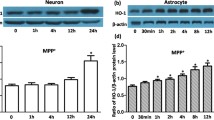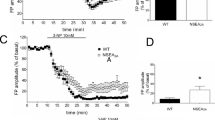Abstract
Brain region specificity is a feature characteristic of neurodegenerative disorders, such as Huntington’s disease (HD). We have studied the brain region-specific vulnerability of striatal compared with cortical and mesencephalic astrocytes treated with 3-nitropropionic acid (NPA), an in vitro model of HD. Mitochondrial dysfunction is involved in neurodegenerative processes. We have previously demonstrated a causal relationship between NPA-induced transcription of the cytochrome c oxidase (COX) subunit IV isoform (cox4i2) and increased oxidative stress leading to higher rates of necrotic cell death in striatal astrocytes by the application of a small interfering RNA knockdown system. Here, we have investigated the correlation of COX IV-2 protein expression with intracellular ATP content, mitochondrial peroxide production, and viability of astrocytes from three different brain regions. In cortical and mesencephalic astrocytes, NPA caused an elevation of cox4i2 transcription as in striatal astroglia. However, increased COX IV-2 and decreased COX IV-1 protein expression levels have been observed only in striatal astrocytes. In agreement with our hypothesis, Striatal astrocytes showed the highest levels of peroxide production and necrotic cell death rates compared with cortical and mesencephalic astroglia. Thus, we suggest that the higher vulnerability of astrocytes from the striatum in our in vitro model of HD is, at least in part, based on brain region-specific differences of the COX IV-2/COX IV-1 protein ratios and accompanied elevated oxidative stress.




Similar content being viewed by others
References
Albin RL (1995) Selective neurodegeneration in Huntington’s disease. Ann Neurol 38:835–836
Arnold S, Beyer C (2009) Neuroprotection by estrogen in the brain: the mitochondrial compartment as presumed therapeutic target. J Neurochem 110:1–11
Arnold S, Kadenbach B (1997) Cell respiration is controlled by ATP, an allosteric inhibitor of cytochrome-c oxidase. Eur J Biochem 249:350–354
Arnold S, Kadenbach B (1999) The intramitochondrial ATP/ADP-ratio controls cytochrome c oxidase activity allosterically. FEBS Lett 443:105–108
Arnold S, Araújo GW de, Beyer C (2008) Gender-specific regulation of mitochondrial fusion and fission gene transcription and viability of cortical astrocytes by steroid hormones. J Mol Endocrinol 41:289–300
Ayala A, Venero JL, Cano J, Machado A (2007) Mitochondrial toxins and neurodegenerative diseases. Front Biosci 12:986–1007
Beal MF (2000) Energetics in the pathogenesis of neurodegenerative diseases. Trends Neurosci 23:298–304
Beal MF (2005) Mitochondria take center stage in aging and neurodegeneration. Ann Neurol 58:495–505
Blum D, Gall D, Cuvelier L, Schiffmann SN (2001) Topological analysis of striatal lesions induced by 3-nitropropionic acid in the Lewis rat. Neuroreport 12:1769–1772
Blum D, Galas MC, Gall D, Cuvelier L, Schiffmann SN (2002) Striatal and cortical neurochemical changes induced by chronic metabolic compromise in the 3-nitropropionic model of Huntington’s disease. Neurobiol Dis 10:410–426
Blum D, Hourez R, Galas MC, Popoli P, Schiffmann SN (2003) Adenosine receptors and Huntington’s disease: implications for pathogenesis and therapeutics. Lancet Neurol 2:366–374
Brouillet E, Hantraye P, Ferrante RJ, Dolan R, Leroy-Willig A, Kowall NW, Beal MF (1995) Chronic mitochondrial energy impairment produces selective striatal degeneration and abnormal choreiform movements in primates. Proc Natl Acad Sci USA 92:7105–7109
Brouillet E, Condé F, Beal MF, Hantraye P (1999) Replicating Huntington's disease phenotype in experimental animals. Prog Neurobiol 59:427–468
Browne SE, Bowling AC, MacGarvey U, Baik MJ, Berger SC, Muqit MM, Bird ED, Beal MF (1997) Oxidative damage and metabolic dysfunction in Huntington’s disease: selective vulnerability of the basal ganglia. Ann Neurol 41:646–653
Cattaneo E, Rigamonti D, Goffredo D, Zuccato C, Squitieri F, Sipione S (2001) Loss of normal huntingtin function: new developments in Huntington’s disease research. Trends Neurosci 24:182–188
Cha JH (2000) Transcriptional dysregulation in Huntington’s disease. Trends Neurosci 23:387–392
Folbergrová J, Ješina P, Haugvicová R, Lisý V, Houštěk J (2009) Sustained deficiency of mitochondrial complex I activity during long periods of survival after seizures induced in immature rats by homocysteic acid. Neurochem Int 56:394–403
Galas MC, Bizat N, Cuvelier L, Bantubungi K, Brouillet E, Schiffmann SN, Blum D (2004) Death of cortical and striatal neurons induced by mitochondrial defect involves differential molecular mechanisms. Neurobiol Dis 15:152–159
Gervais FG, Singaraja R, Xanthoudakis S, Gutekunst CA, Leavitt BR, Metzler M, Hackam AS, Tam J, Vaillancourt JP, Houtzager V, Rasper DM, Roy S, Hayden MR, Nicholson DW (2002) Recruitment and activation of caspase-8 by the Huntingtin-interacting protein Hip-1 and a novel partner Hippi. Nat Cell Biol 4:95–105
Grossman LI, Lomax MI (1997) Nuclear genes for cytochrome c oxidase. Biochim Biophys Acta 1352:174–192
Gu M, Gash MT, Mann VM, Javoy-Agid F, Cooper JM, Schapira AH (1996) Mitochondrial defect in Huntington’s disease caudate nucleus. Ann Neurol 39:385–389
Horvat S, Beyer C, Arnold S (2006) Effect of hypoxia on the transcription pattern of subunit isoforms and the kinetics of cytochrome c oxidase in cortical astrocytes and cerebellar neurons. J Neurochem 99:937–951
Kadenbach B, Arnold S (1999) A second mechanism of respiratory control. FEBS Lett 447:131–134
Kadenbach B, Hüttemann M, Arnold S, Lee I, Bender E (2000) Mitochondrial energy metabolism is regulated via nuclear-coded subunits of cytochrome c oxidase. Free Radic Biol Med 29:211–221
Kadenbach B, Arnold S, Lee I, Hüttemann M (2004) The possible role of cytochrome c oxidase in stress-induced apoptosis and degenerative diseases. Biochim Biophys Acta 1655:400–408
Kumar P, Kalonia H, Kumar A (2010) Huntington’s disease: pathogenesis to animal models. Pharmacol Rep 62:1–14
Mittoux V, Ouary S, Monville C, Lisovoski F, Poyot T, Conde F, Escartin C, Robichon R, Brouillet E, Peschanski M, Hantraye P (2002) Corticostriatopallidal neuroprotection by adenovirus-mediated ciliary neurotrophic factor gene transfer in a rat model of progressive striatal degeneration. J Neurosci 22:4478–4486
Nishino H, Shimano Y, Kumazaki M, Sakurai T (1995) Chronically administered 3-nitropropionic acid induces striatal lesion attributed to dysfunction of the blood-brain barrier. Neurosci Lett 186:161–164
Ona VO, Li M, Vonsattel JP, Andrews LJ, Khan SQ, Chung WM, Frey AS, Menon AS, Li XJ, Stieg PE, Yuan J, Penney JB, Young AB, Cha JH, Friedlander RM (1999) Inhibition of caspase-1 slows disease progression in a mouse model of Huntington’s disease. Nature 399:263–267
Panov AV, Gutekunst CA, Leavitt BR, Hayden MR, Burke JR, Strittmatter WJ, Greenamyre JT (2002) Early mitochondrial calcium defects in Huntington’s disease are a direct effect of polyglutamines. Nat Neurosci 5:731–736
Pellerin L (2003) Lactate as a pivotal element in neuron-glia metabolic cooperation. Neurochem Int 43:331–338
Sanchez I, Xu CJ, Juo P, Kakizaka A, Blenis J, Yuan J (1999) Caspase-8 is required for cell death induced by expanded polyglutamine repeats. Neuron 22:623–633
Saudou F, Finkbeiner S, Devys D, Greenberg ME (1998) Huntingtin acts in the nucleus to induce apoptosis but death does not correlate with the formation of intranuclear inclusions. Cell 95:55–66
Sawa A, Wiegand GW, Cooper J, Margolis RL, Sharp AH, Lawler JF Jr, Greenamyre JT, Snyder SH, Ross CA (1999) Increased apoptosis of Huntington disease lymphoblasts associated with repeat length-dependent mitochondrial depolarization. Nat Med 5:1194–1198
Schapira AH (1997) Mitochondrial function in Huntington’s disease: clues for pathogenesis and prospects for treatment. Ann Neurol 41:141–142
Singh S, Misiak M, Beyer C, Arnold S (2009) Cytochrome c oxidase isoform IV-2 is involved in 3-nitropropionic acid-induced toxicity in striatal astrocytes. Glia 57:1480–1491
Subramaniam S, Sixt KM, Barrow R, Snyder SH (2009) Rhes, a striatal specific protein, mediates mutant-huntingtin cytotoxicity. Science 324:1327–1330
Tsukihara T, Aoyama H, Yamashita E, Tomizaki T, Yamaguchi H, Shinzawa-Itoh K, Nakashima R, Yaono R, Yoshikawa S (1996) The whole structure of the 13-subunit oxidized cytochrome c oxidase at 2.8 Å. Science 272:1136–1144
Villani G, Greco M, Papa S, Attardi G (1998) Low reserve of cytochrome c oxidase capacity in vivo in the respiratory chain of a variety of human cell types. J Biol Chem 273:31829–31836
Vonsattel JP, Myers RH, Stevens TJ, Ferrante RJ, Bird ED, Richardson EP Jr (1985) Neuropathological classification of Huntington’s disease. J Neuropathol Exp Neurol 44:559–577
Zuccato C, Ciammola A, Rigamonti D, Leavitt BR, Goffredo D, Conti L, MacDonald ME, Friedlander RM, Silani V, Hayden MR, Timmusk T, Sipione S, Cattaneo E (2001) Loss of huntingtin mediated BDNF gene transcription in Huntington’s disease. Science 293:493–498
Acknowledgements
We thank Petra Ibold for excellent technical assistance and Sascha Drewlo for helpful technical support.
Author information
Authors and Affiliations
Corresponding author
Additional information
This work was supported by the Deutsche Forschungsgemeinschaft (AR 343/1-3 and AR 343/4-1), the START-Program (S.A.) and IZKF BIOMAT. (S.A., C.B.) of the Faculty of Medicine, RWTH Aachen University.
Rights and permissions
About this article
Cite this article
Misiak, M., Singh, S., Drewlo, S. et al. Brain region-specific vulnerability of astrocytes in response to 3-nitropropionic acid is mediated by cytochrome c oxidase isoform expression. Cell Tissue Res 341, 83–93 (2010). https://doi.org/10.1007/s00441-010-0995-3
Received:
Accepted:
Published:
Issue Date:
DOI: https://doi.org/10.1007/s00441-010-0995-3




